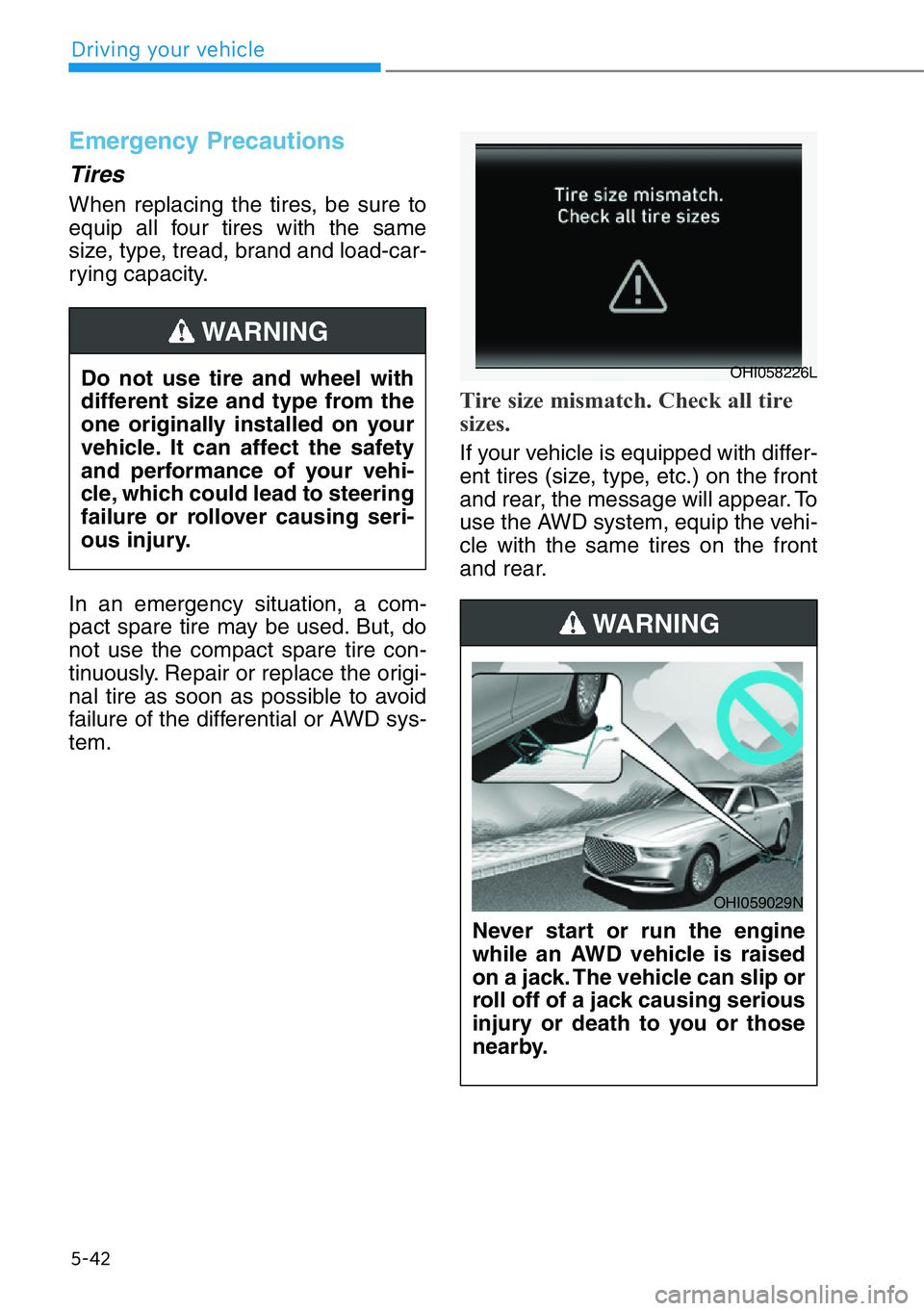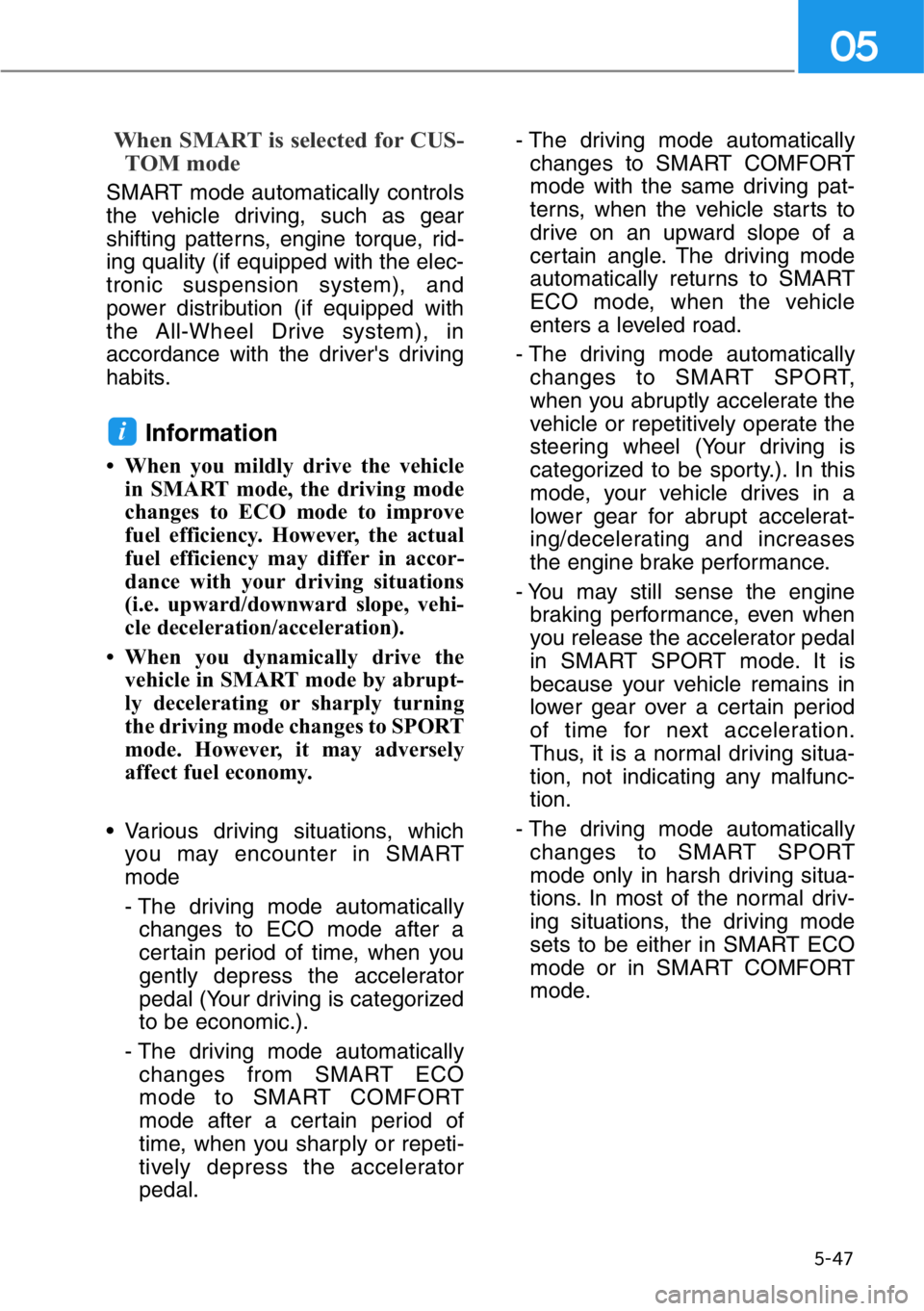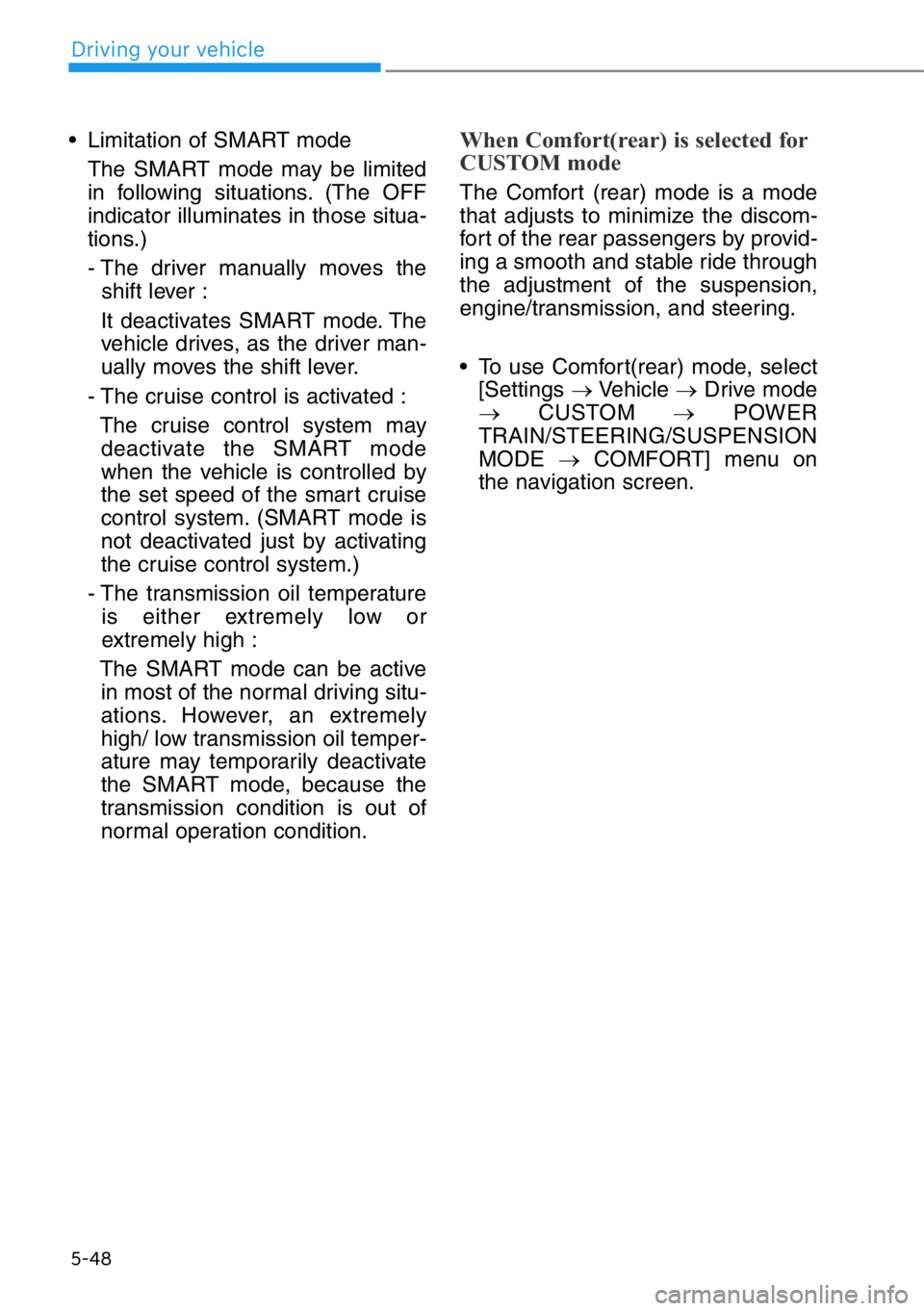GENESIS G90 2021 Owner's Manual
Manufacturer: GENESIS, Model Year: 2021, Model line: G90, Model: GENESIS G90 2021Pages: 538, PDF Size: 13.02 MB
Page 291 of 538

Using All Wheel Drive (AWD)
The All Wheel Drive system delivers
engine power to front and rear
wheels for maximum traction. AWD is
useful when extra traction is
required, such as when driving on,
muddy, wet, or snow-covered roads.
If the system determines there is a
need for four wheel drive, the
engine's driving power is distributed
to all four wheels automatically.
ALL WHEEL DRIVE (AWD) (IF EQUIPPED)
5-39
05
If the AWD warning light ( )
stays on the instrument cluster,
your vehicle may have a mal-
function with the AWD system.
When the AWD warning light
( ) illuminates have your
vehicle checked by an author-
ized retailer of Genesis Branded
products as soon as possible.
WARNING
To reduce the risk of SERIOUS
INJURY or DEATH:
• Do not drive in conditions that
exceed the vehicles intended
design such as challenging
off-road conditions.
• Avoid high speeds when cor-
nering or turning.
• Do not make quick steering
wheel movements, such as
sharp lane changes or fast,
sharp turns.
• The risk of a rollover is great-
ly increased if you lose con-
trol of your vehicle at highway
speeds.
• Loss of control often occurs if
two or more wheels drop off
the roadway and the driver
over steers to reenter the
roadway.
• In the event your vehicle
leaves the roadway, do not
steer sharply. Instead, slow
down before pulling back into
the travel lanes.
• Always drive safely and use
caution when driving an AWD
vehicle.
WARNING
Page 292 of 538

Information
• Do not drive in water if the level is
higher than the bottom of the vehi-
cle.
• Check your brake condition once
you are out of mud or water.
Depress the brake pedal several
times as you move slowly until you
feel normal braking return.
• Shorten your scheduled mainte-
nance interval if you drive in off-
road conditions such as sand, mud
or water (see "Maintenance Under
Severe Usage Conditions" in chap-
ter 7).
• Make sure that an AWD vehicle is
towed by flatbed tow truck.
For safe AWD operation
Before driving
• Make sure all passengers are
wearing seat belts.
• Sit upright and adjust the steering
wheel to a position comfortable for
you to drive.
Driving on snow-covered or icy
roads
• Start off slowly by applying the
accelerator pedal gently.
• Use of snow tires is recommended.
For more information on Snow
Tires refer to "Winter Driving" in
this chapter.
• Keep sufficient distance between
your vehicle and the vehicle in front
of you.
• When approaching a stop sign or
stop light, release the accelerator
pedal to provide engine braking
during deceleration.
• Avoid speeding, rapid acceleration,
sudden brake applications, and
sharp turns to prevent skids.
i
5-40
Driving your vehicle
Page 293 of 538

Driving in sand or mud
• Maintain slow and constant speed.
• Keep sufficient distance between
your vehicle and the vehicle in front
of you.
• Reduce vehicle speed and always
check the road condition.
• Avoid speeding, rapid acceleration,
sudden brake applications, and
sharp turns to prevent getting
stuck.
When the vehicle is stuck in snow,
sand or mud, avoid running the
engine continuously at high rpm,
doing so may damage the tires,
transmission, differential or AWD
system.
Information
• When using Snow Tires, mount
them on all four wheels.
• When using AutoSock
®(fabric snow
chain), install them on the rear tires.
For more information on Snow Tires
and Tire Chains, refer to "Winter
Driving" in this chapter.
Driving up or down hills
• Driving uphill
- Before starting off, check if it is
possible to drive uphill.
- Drive as straight as possible.
• Driving downhill
- Do not change gear while driving
downhill. Select gear before driv-
ing downhill.
- Drive slowly and select Manual
Shift Mode to provide engine
braking while driving downhill.
- Drive straight as possible.
i
NOTICE
5-41
05
Exercise extreme caution driv-
ing up or down steep hills. The
vehicle may flip depending on
the grade, terrain and water/
mud conditions.
WARNING
Page 294 of 538

Emergency Precautions
Tires
When replacing the tires, be sure to
equip all four tires with the same
size, type, tread, brand and load-car-
rying capacity.
In an emergency situation, a com-
pact spare tire may be used. But, do
not use the compact spare tire con-
tinuously. Repair or replace the origi-
nal tire as soon as possible to avoid
failure of the differential or AWD sys-
tem.
Tire size mismatch. Check all tire
sizes.
If your vehicle is equipped with differ-
ent tires (size, type, etc.) on the front
and rear, the message will appear. To
use the AWD system, equip the vehi-
cle with the same tires on the front
and rear.
5-42
Driving your vehicle
Do not use tire and wheel with
different size and type from the
one originally installed on your
vehicle. It can affect the safety
and performance of your vehi-
cle, which could lead to steering
failure or rollover causing seri-
ous injury.
WARNING
OHI058226L
Never start or run the engine
while an AWD vehicle is raised
on a jack. The vehicle can slip or
roll off of a jack causing serious
injury or death to you or those
nearby.
WARNING
OHI059029N
Page 295 of 538

Towing
AWD vehicles must be towed with all
wheels off the ground, either on a
flatbed tow truck or using doilies.
For more details, refer to "Towing"
in chapter 6.
Vehicle inspection
• If the vehicle needs to be operated
on a vehicle lift do not attempt to
stop any of the four wheels for turn-
ing. This could damage the sys-
tem.
• Never engage the parking brake
while running the engine on a car
lift. This may damage the AWD
system.
Dynamometer testing
An AWD vehicle must be tested on a
special four wheel chassis dynamome-
ter.
An AWD vehicle should not be tested
on a 2WD roll tester. If a 2WD roll
tester must be used, perform the fol-
lowing procedure:
1. Check the tire pressures recom-
mended for your vehicle.
2. Place the rear wheels on the roll
tester for a speedometer test as
shown in the illustration.
3. Release the parking brake.
4. Place the front wheels on the tem-
porary free roller as shown in the
illustration.
5-43
05
OHI058031Roll Tester (Speedometer)
Temporary Free Roller
Keep away from the front of the
vehicle while the vehicle is in
gear on the dynamometer. The
vehicle can jump forward and
cause serious injury or death.
WARNING
Page 296 of 538

5-44
Driving your vehicle
Electronic Control Suspension
(ECS)
The Electronic Control Suspension
controls the vehicle suspension
automatically to maximize driving
comfort by taking into account the
driving conditions such as speed,
surface of the road, cornering, stop-
ping requirements and acceleration.
ECS (Electronic Control
Suspension) malfunction indi-
cator
Check Electronic Suspension
If the ECS warning message comes
on, you may have a problem with the
ECS system. Have the system be
checked by an authorized retailer of
Genesis Branded products.
Dynamic Stability Damping
Control (DSDC)
The Dynamic Stability Damping
Control provides comfort riding and
driving stability by meticulously opti-
mizing the suspension power during
sharp curving or abrupt obstacle
avoidance.
Operating conditions
• The DSDC is activated, when driv-
ing speed exceeds 30 mph (50
km/h).
• The DSDC does not operate, when
the Electronic Stability Control is
deactivated.
The Dynamic Stability Damping
Control does not operate, when
there is a malfunction with the
Electronic Stability Control.
The Dynamic Stability Damping
Control operation is limited in fol-
lowing situations:
- There are wide variations in tire
pressures.
- The vehicle is driven on a steep
slope.
- The vehicle is driven on a rough,
rugged surface.
NOTICE
GENESIS ADAPTIVE CONTROL SUSPENSION (IF EQUIPPED)
NEVER install any tires/wheels
in different sizes or of different
models on your vehicle. It may
cause a malfunction of the
Dynamic Stability Damping
Control.
WARNING
OHI048132L
Page 297 of 538

5-45
05
DRIVE MODE INTEGRATED CONTROL SYSTEM
Drive Mode
The drive mode may be selected
according to the driver's preference
or road condition.
The mode changes whenever the
DRIVE MODE button is pressed.
• COMFORT mode :
COMFORT mode provides smooth
driving and comfortable riding.
• SPORT mode :
SPORT mode provides sporty but
firm riding.
• ECO mode :
ECO mode helps improve fuel effi-
ciency for eco-friendly driving.
• CUSTOM mode :
The driver can separately adjust
modes of each driving system.
COMFORT mode
When COMFORT mode
is selected by pressing
the DRIVE MODE button,
the COMFORT indicator
will illuminate on the
instrument cluster.
SPORT
When SPORT mode is
selected by pressing the
DRIVE MODE button, the
SPORT indicator will illu-
minate on the instrument
cluster.
• Whenever the engine is restarted,
the drive mode will revert back to
COMFORT mode. If SPORT mode
is desired, re-select SPORT mode.
• When SPORT mode is activated:
- The engine rpm will tend to
remain raised over a certain
length of time even after releas-
ing the accelerator
- Upshifts are delayed when accel-
erating
- Seat bolsters are active (if
equipped)
Information
In SPORT mode, the fuel efficiency
may decrease.
i
OHI058060L
OHI059236N
Page 298 of 538

5-46
Driving your vehicle
ECO mode
When ECO mode is
selected by pressing the
DRIVE MODE button, the
ECO indicator will illumi-
nate on the instrument
cluster.
• If the vehicle is set to ECO mode,
when the engine is turned OFF
and restarted the drive mode set-
ting will remain in ECO mode.
Information
Fuel efficiency depends on the driver's
driving habit and road condition.
When ECO mode is activated:
• The acceleration response may be
slightly reduced if the accelerator
pedal is depressed moderately.
• The air conditioner performance
may be limited.
• The shift pattern of the automatic
transmission may change.
• The engine noise may be louder at
some automatic transmission
shifts as down-shift requires press-
ing down more on the accelerator.
The above situations are normal
conditions when ECO mode is acti-
vated to help improve fuel efficiency.
Limitation of ECO mode operation:
If the following conditions occur while
ECO mode is operating, the system
operation is limited even though
there is no change in the ECO indi-
cator.
• When the coolant temperature is
low:
The system will be limited until
engine performance becomes nor-
mal.
• When driving up a hill:
The system will be limited to gain
power when driving uphill because
engine torque is restricted.
• When driving the vehicle in manual
shift mode using the paddle shifter.
The system will be limited accord-
ing to the shift location.
CUSTOM mode
When CUSTOM mode is
selected by pressing the
DRIVE MODE button, the
CUSTOM mode indicator
will illuminate on the
instrument cluster.
• In CUSTOM mode, the driver can
select separate modes and combine
them in the AVN system screen.
- Engine/Transmission: ECO/
COMFORT/SPORT/SMART
/Comfort(rear)
- Steering wheel: COMFORT/
SPORT/Comfort(rear)
- Suspension:
COMFORT/SPORT/Comfort(rear)
- AWD system: ECO/COMFORT/
SPORT
For detailed information, scan the
QR code in a separately supplied
simple manual.
i
Page 299 of 538

5-47
05
When SMART is selected for CUS-
TOM mode
SMART mode automatically controls
the vehicle driving, such as gear
shifting patterns, engine torque, rid-
ing quality (if equipped with the elec-
tronic suspension system), and
power distribution (if equipped with
the All-Wheel Drive system), in
accordance with the driver's driving
habits.
Information
• When you mildly drive the vehicle
in SMART mode, the driving mode
changes to ECO mode to improve
fuel efficiency. However, the actual
fuel efficiency may differ in accor-
dance with your driving situations
(i.e. upward/downward slope, vehi-
cle deceleration/acceleration).
• When you dynamically drive the
vehicle in SMART mode by abrupt-
ly decelerating or sharply turning
the driving mode changes to SPORT
mode. However, it may adversely
affect fuel economy.
• Various driving situations, which
you may encounter in SMART
mode
- The driving mode automatically
changes to ECO mode after a
certain period of time, when you
gently depress the accelerator
pedal (Your driving is categorized
to be economic.).
- The driving mode automatically
changes from SMART ECO
mode to SMART COMFORT
mode after a certain period of
time, when you sharply or repeti-
tively depress the accelerator
pedal.- The driving mode automatically
changes to SMART COMFORT
mode with the same driving pat-
terns, when the vehicle starts to
drive on an upward slope of a
certain angle. The driving mode
automatically returns to SMART
ECO mode, when the vehicle
enters a leveled road.
- The driving mode automatically
changes to SMART SPORT,
when you abruptly accelerate the
vehicle or repetitively operate the
steering wheel (Your driving is
categorized to be sporty.). In this
mode, your vehicle drives in a
lower gear for abrupt accelerat-
ing/decelerating and increases
the engine brake performance.
- You may still sense the engine
braking performance, even when
you release the accelerator pedal
in SMART SPORT mode. It is
because your vehicle remains in
lower gear over a certain period
of time for next acceleration.
Thus, it is a normal driving situa-
tion, not indicating any malfunc-
tion.
- The driving mode automatically
changes to SMART SPORT
mode only in harsh driving situa-
tions. In most of the normal driv-
ing situations, the driving mode
sets to be either in SMART ECO
mode or in SMART COMFORT
mode.
i
Page 300 of 538

5-48
Driving your vehicle
• Limitation of SMART mode
The SMART mode may be limited
in following situations. (The OFF
indicator illuminates in those situa-
tions.)
- The driver manually moves the
shift lever :
It deactivates SMART mode. The
vehicle drives, as the driver man-
ually moves the shift lever.
- The cruise control is activated :
The cruise control system may
deactivate the SMART mode
when the vehicle is controlled by
the set speed of the smart cruise
control system. (SMART mode is
not deactivated just by activating
the cruise control system.)
- The transmission oil temperature
is either extremely low or
extremely high :
The SMART mode can be active
in most of the normal driving situ-
ations. However, an extremely
high/ low transmission oil temper-
ature may temporarily deactivate
the SMART mode, because the
transmission condition is out of
normal operation condition.
When Comfort(rear) is selected for
CUSTOM mode
The Comfort (rear) mode is a mode
that adjusts to minimize the discom-
fort of the rear passengers by provid-
ing a smooth and stable ride through
the adjustment of the suspension,
engine/transmission, and steering.
• To use Comfort(rear) mode, select
[Settings →Vehicle →Drive mode
→CUSTOM →POWER
TRAIN/STEERING/SUSPENSION
MODE →COMFORT] menu on
the navigation screen.